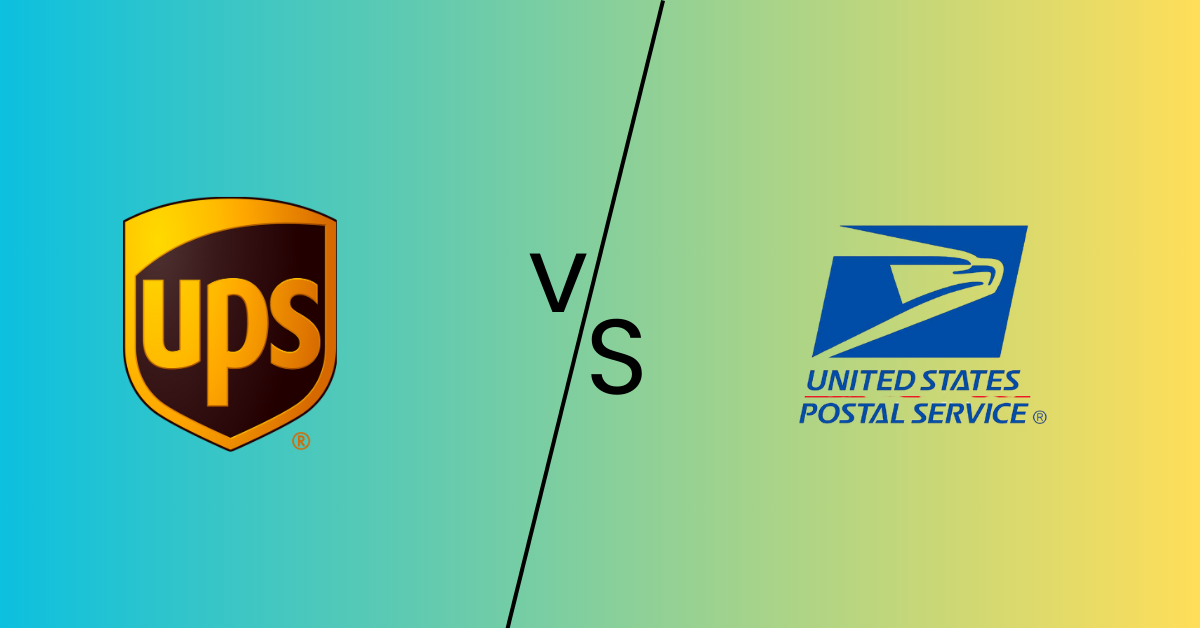UPS vs USPS: Comparison Guide For 2024

The United Parcel Service (UPS) and the United States Postal Service (USPS) rivalry is only going to get stronger as 2024 approaches, influencing both consumer and business preferences. We examine the finer points of UPS Vs.USPS in this in-depth guide, analyzes their advantages, disadvantages, and distinctive characteristics that make them stand out in the ever-changing shipping and logistics industry. This comparison guide is intended to be your go-to reference for making informed decisions in the shipping industry of 2024, whether you're a small business owner looking for affordable solutions or an individual navigating the complexities of sending and receiving parcels. Come along as we explore the difference between ups and usps, analyzing their offerings, costs, and technological developments to assist you.
UPS vs USPS: Meaning
UPS( United Parcel Service)

UPS (United Parcel Service) is an American multinational shipping & receiving and supply chain management company founded in 1907. Originally known as the American Messenger Company specializing in telegraphs, UPS has grown to become a Fortune 500 company and one of the world's largest shipping couriers.UPS is primarily known for its ground shipping services but also offers air shipping, freight forwarding, and logistics services. The company has a large network of shipping facilities and vehicles, which allows it to offer fast and reliable delivery times. UPS also offers a variety of value-added services, such as tracking, insurance, and signature confirmation.
USPS (United States Postal Service)

USPS (United States Postal Service), also known as the Post Office or U.S. Mail, is an independent agency within the U.S. government, established in 1775. It stands as one of the few government entities explicitly authorized by the Constitution and boasts the impressive feat of delivering mail to every residential and business address in the nation, exceeding 167 million deliveries. USPS operates on a non-profit basis, funding itself through the sale of postage, products, and services. This translates to generally lower rates for basic mail and packages, particularly for lighter items and those traveling shorter distances.
UPS vs USPS: Features
Choosing the right shipping carrier in USPS vs UPS depends on your specific needs. Here's a breakdown of key features for UPS and USPS to help you decide:
UPS vs USPS Speed
UPS: Offers a wider range of expedited options, including Next Day Air and 2nd Day Air, guaranteeing faster delivery times. Ground shipping is also generally faster than USPS.
USPS: Offers faster options like Priority Mail Express (1-2 days) and Priority Mail (2-3 days), but speeds can vary depending on location. Standard First-Class Mail can take longer.
USPS vs UPS Price
UPS: Generally more expensive than USPS, especially for expedited options. Offers volume discounts for high-volume shippers.
USPS: Generally more affordable, especially for lightweight packages and those traveling within the US. Flat-rate options offer predictable costs.
UPS vs USPS Coverage
UPS: Extensive domestic and international network, reaching over 220 countries and territories.
USPS: Delivers to every address in the US and offers international shipping to many countries.
UPS vs USPS Services
UPS: a wide range of value-added services like signature confirmation, tracking, insurance, and freight forwarding.
USPS: Offers tracking, insurance, PO boxes, Saturday delivery, and media mail for specific items.
UPS vs USPS Additional points
UPS: More flexible pick-up and drop-off options with self-service boxes and access points.
USPS: Conveniently located post offices offer drop-off points and retail services.
UPS vs USPS: Shipping Rates
Price is often a major deciding factor when choosing between UPS and USPS. Here's a deeper dive into UPS vs USPS international shipping & domestic shipping rates:
General Trends
USPS: Generally cheaper for lighter packages (under 2 pounds) and domestic shipments within the US. Offers flat-rate options for predictable costs.
UPS: Typically more expensive overall, especially for expedited options. Offers volume discounts for high-volume shippers.
Key Differences
Package Weight:
- Under 2 pounds: USPS First-Class Mail is often the most affordable option.
- 2-5 pounds: USPS Priority Mail starts to become competitive, especially with flat-rate boxes.
- 5-10 pounds: UPS Ground and USPS Priority Mail can be close in price, depending on distance.
- Over 10 pounds: UPS Ground becomes more expensive than Priority Mail, but may offer faster delivery.
Delivery Speed
Expedited Shipping: UPS generally wins for guaranteed speed at a premium. USPS Priority Mail Express offers a faster option, but may be more expensive.
Standard Shipping: USPS Priority Mail is often faster and more affordable than UPS Ground for domestic shipments.
UPS vs USPS: Pros & Cons
Choosing between UPS and USPS can be like picking sides in a superhero movie - each has its strengths and weaknesses. To help you decide which shipping carrier is your hero, let's explore the pros and cons of each:
UPS Pros & Cons:
Pros:
- Speed: Offers a wider range of guaranteed-delivery options, ideal for time-sensitive shipments.
- Extensive Network: Delivers to over 220 countries and territories, making it ideal for international shipping.
- Value-Added Services: Provides a wider range of services like signature confirmation, advanced tracking, and specialized packaging.
- Flexible Pick-Up & Drop-Off: Offers self-service kiosks and access points for increased convenience.
Cons:
- Cost: Generally more expensive than USPS, especially for slower shipping options.
- Limited Coverage: Doesn't deliver to every US address, unlike USPS.
- Less Convenient Drop-Off: Requires visiting UPS locations or arranging a pick-up, compared to USPS's widespread post offices.
USPS Pros & Cons:
Pros:
- Cost-Effective: Generally cheaper for lightweight packages and domestic shipments.
- Universal Coverage: Delivers to every US address, including PO boxes.
- Convenient Drop-Off: An extensive network of post offices provides easily accessible drop-off points.
- Unique Services: Offers Saturday delivery and media mail for specific items.
Cons:
- Slower Speed: Standard shipping can be slower than UPS Ground, particularly for longer distances.
- Limited International Reach: Offers international shipping, but covers fewer countries than UPS.
- Less Control: Tracking updates may be less detailed compared to UPS's advanced options.
- Limited Value-Added Services: Offers fewer add-on services compared to UPS.
Grow your Shopify Store with Manifest AI

Growing your Shopify store with Manifest AI involves integrating advanced AI technology to streamline operations and enhance customer interactions. This tool adapts to your business needs, offering personalized experiences to your customers and providing valuable insights to help you make informed decisions.
Benefits include:
- Improved Customer Service: Automates responses to customer inquiries, ensuring quick and accurate support, which can significantly enhance customer satisfaction.
- Personalized Shopping Experiences: Analyzes customer data to offer personalized product recommendations, making shopping more engaging and increasing the likelihood of purchases.
- Efficient Operations: Helps streamline various aspects of your business, from inventory management to customer service, allowing you to focus more on growth and less on day-to-day tasks.
- Data-Driven Insights: Provides analytics on customer behavior and store performance, enabling you to tailor your marketing strategies and product offerings for better results.
- Increased Sales: By improving the overall customer experience and offering targeted recommendations, Manifest AI can help boost your store's conversion rates and average order values.
UPS vs USPS vs FedEx
Let's understand this comparison through a comparison chart of UPS vs USPS vs FedEX:

Conclusion
In the vast shipping market, UPS and USPS are prepared to meet your delivery requirements. The ultimate victor isn't determined by one thing, but rather by giving your unique needs top priority. Want international delivery that happens in an instant? Take a look at UPS's premium choices. Want to send lighter things domestically at a reasonable cost? USPS could be your saving grace. Recall that there are factors such as cost, speed, coverage, and convenience. Thus, in 2024, assess your needs, evaluate rates, and select the carrier that offers value and satisfaction.
Which Is Cheaper USPS or UPS?
Generally, USPS is cheaper than UPS, especially for: Lighter packages (under 2 pounds) and Domestic shipments within the US with Slower shipping options However, UPS can be cheaper for Heavy packages (over 10 pounds), Expedited shipping, International shipping (sometimes) Ultimately, the best choice depends on your specific package weight, shipping distance, and speed needs.
Are USPS and UPS The Same?
No, USPS and UPS are distinct delivery services:
- USPS: Government-run, universal coverage, generally cheaper for domestic & lighter packages.
- UPS: Private company, wider international reach, faster options but often pricier.

.png)
